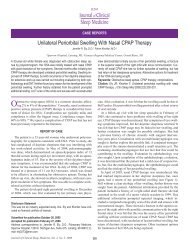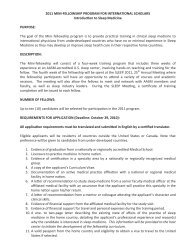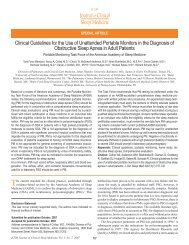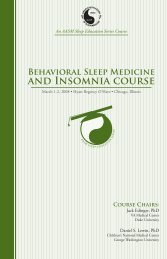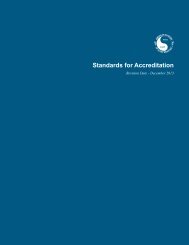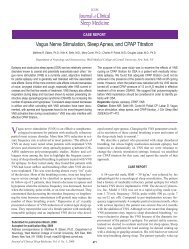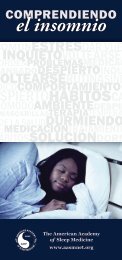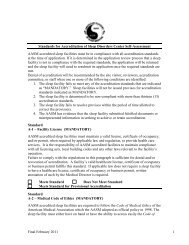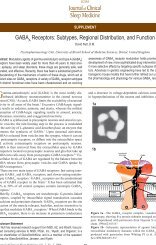Insomnia and Daytime Napping in Older Adults - ResearchGate
Insomnia and Daytime Napping in Older Adults - ResearchGate
Insomnia and Daytime Napping in Older Adults - ResearchGate
You also want an ePaper? Increase the reach of your titles
YUMPU automatically turns print PDFs into web optimized ePapers that Google loves.
S Ancoli-Israel <strong>and</strong> JL Mart<strong>in</strong><br />
Figure 2—Six-year mortality rates <strong>in</strong> men <strong>and</strong> women accord<strong>in</strong>g to<br />
rest or nap status. *p = .02 for men who napped 1 hour or more vs<br />
those who napped less than 1 hour.<br />
Repr<strong>in</strong>ted with permission from Bursztyn et al. The siesta <strong>and</strong> mortality<br />
<strong>in</strong> the elderly: effect of rest without sleep <strong>and</strong> daytime sleep<br />
duration. Sleep 2002;25:187-91.<br />
pers, even after adjust<strong>in</strong>g for traditional cardiovascular disease<br />
risk factors <strong>and</strong> after 12 years of follow-up. 14,63,64 Thus, napp<strong>in</strong>g<br />
(siestas) appeared to be uniquely associated with mortality. 63<br />
Further analyses of these results suggest that napp<strong>in</strong>g may have<br />
a stronger association with mortality <strong>in</strong> men than women. 14 Although<br />
the 1999 study of Bursztyn et al observed a higher prevalence<br />
of napp<strong>in</strong>g among MI survivors (78% vs 58% among those<br />
without previous MIs; p = .009), 63 logistic regression analysis<br />
controll<strong>in</strong>g for presence/absence of previous MIs found that napp<strong>in</strong>g<br />
was associated with <strong>in</strong>creased mortality risk <strong>in</strong>dependent<br />
of prior MI history (OR, 1.78; 95% CI, 1.0-3.2). Furthermore,<br />
the association was still significant <strong>and</strong> rema<strong>in</strong>ed double that of<br />
nonnappers <strong>in</strong> multivariate analysis (Table 2). Most of the deaths<br />
were caused by vascular diseases (cardiac, 31%; cerebrovascular,<br />
13%); cancer <strong>and</strong> other causes accounted for 33% <strong>and</strong> 23% of<br />
deaths, respectively.<br />
Bursztyn et al extended these f<strong>in</strong>d<strong>in</strong>gs <strong>in</strong> a subsequent study<br />
that stratified subjects accord<strong>in</strong>g to daytime napp<strong>in</strong>g, daytime<br />
rest<strong>in</strong>g without napp<strong>in</strong>g, or no daytime napp<strong>in</strong>g or rest<strong>in</strong>g. 14 The<br />
6-year mortality rate for those who napped was more than double<br />
the rate for those who neither napped nor rested without sleep<strong>in</strong>g<br />
(ie, ceased strenuous activity without sleep<strong>in</strong>g; 19.0% vs 9.5%,<br />
respectively); the rate for those who only rested was 10.9% (p <<br />
.02). The mortality risk for those who napped for 1 hour or more<br />
was more than double the risk for those who only rested (OR,<br />
2.6; 95% CI, 1.14-6.23) <strong>and</strong> almost quadruple the risk for those<br />
who neither napped nor rested (OR, 3.68; 95% CI, 1.36-9.92).<br />
The mortality rate <strong>in</strong> men was significantly higher than the rate <strong>in</strong><br />
women (19% vs 10%, respectively; p = 0.006). In men, nap duration<br />
was a significant mortality variable (Figure 2). The mortality<br />
rate <strong>in</strong> men who napped for less than 1 hour was 14%, compared<br />
with 28% <strong>in</strong> men who napped for 1 hour or more (p = .02). In multivariate<br />
analysis <strong>in</strong>corporat<strong>in</strong>g conventional risk factors, duration<br />
of daytime sleep was significantly associated with mortality for<br />
men (p = .02). The other significant covariates were lack of exercise,<br />
cerebrovascular accident, <strong>and</strong> diabetes <strong>in</strong> men <strong>and</strong> diabetes<br />
<strong>and</strong> prior MIs <strong>in</strong> women, consistent with a previous f<strong>in</strong>d<strong>in</strong>g of<br />
vascular disease as a major cause of mortality. 63 Men who napped<br />
1 to 2 hours daily had a significantly <strong>in</strong>creased mortality OR (OR,<br />
2.61; 95% CI, 1.00-6.81) relative to those who neither napped nor<br />
rested (OR, 0.80; 95% CI, 0.34-2.38). Although duration of naps<br />
as a cont<strong>in</strong>uous variable was not predictive of mortality for women,<br />
women who napped for less than 1 hour <strong>and</strong> those who napped<br />
for 1 to 2 hours had over 4- <strong>and</strong> 5-fold respective <strong>in</strong>creases <strong>in</strong> risk<br />
of mortality; ORs were 4.67 (95% CI, 1.22-17.80) <strong>and</strong> 5.57 (95%<br />
CI, 1.05-24.49), respectively.<br />
Bursztyn <strong>and</strong> colleagues cont<strong>in</strong>ued exam<strong>in</strong><strong>in</strong>g the relationship<br />
between naps <strong>and</strong> mortality with a 12-year follow-up of these<br />
same older adults. 64 Results showed that 74% of those not napp<strong>in</strong>g<br />
regularly survived, compared with only 64% who regularly<br />
took naps (p < .01). Hazard ratio for mortality for those who<br />
napped was 1.6 (CI 1.2-2.7). These results extended the f<strong>in</strong>d<strong>in</strong>g<br />
of the 6-year observations. Increased mortality was <strong>in</strong>dependent<br />
of previous cancer, previous ischemic heart disease, hypertension,<br />
diabetes, smok<strong>in</strong>g, renal dysfunction, or lipid levels, as well as<br />
activities of daily liv<strong>in</strong>g <strong>and</strong> quality of life.<br />
The f<strong>in</strong>al study exam<strong>in</strong>ed the effects of daytime napp<strong>in</strong>g <strong>in</strong> relation<br />
to all-cause <strong>and</strong> cardiovascular mortality, while controll<strong>in</strong>g<br />
for many recognized predictors of mortality. 65 The sample was<br />
part of the Kiryat Yovel Health Study <strong>and</strong> sampled all 1859 residents<br />
of the community 50 years of age or older for an average of<br />
10 years. Data were collected on the number <strong>and</strong> duration of daytime<br />
naps, <strong>in</strong> addition to a wealth of potential mortality covariates.<br />
In multivariate models among men, there was an association<br />
between mortality <strong>in</strong> men between the ages of 65 to 74 years who<br />
napped (def<strong>in</strong>ed as those who self-reported usually napp<strong>in</strong>g dur<strong>in</strong>g<br />
the day) relative to those who did not (p = .008; OR, 2.21;<br />
95% CI, 1.28-3.80). 65 Exclusion of patients with chronic conditions<br />
prior to assessment, however, reduced the magnitude of this<br />
association. Long naps (> 2 hours) were consistently associated<br />
with excess mortality risk <strong>in</strong> men regardless of age. <strong>Napp<strong>in</strong>g</strong> was<br />
not associated with mortality <strong>in</strong> women.<br />
It is important to note that these studies could not control for all<br />
causes of <strong>in</strong>creased mortality associated with illnesses that cause<br />
daytime sleep<strong>in</strong>ess <strong>and</strong> lead to napp<strong>in</strong>g; therefore, cause <strong>and</strong> effect<br />
have not been established. More research is needed to more<br />
clearly elucidate whether daytime napp<strong>in</strong>g <strong>in</strong>creases the risk of<br />
mortality.<br />
EFFECTS ON NOCTURNAL SLEEP<br />
The effect of napp<strong>in</strong>g on nocturnal sleep <strong>in</strong> the elderly is a<br />
controversial issue. 41 Theoretically, napp<strong>in</strong>g may perpetuate a vicious<br />
cycle of sleep fragmentation, decreased sleep efficiency, fatigue,<br />
<strong>and</strong> napp<strong>in</strong>g. 46-48 Studies exam<strong>in</strong><strong>in</strong>g the general population<br />
of elderly adults have reported an association between napp<strong>in</strong>g<br />
<strong>and</strong> nocturnal sleep difficulties, although the duration of daytime<br />
naps appears to be a key factor. Studies describ<strong>in</strong>g the effects<br />
of napp<strong>in</strong>g <strong>and</strong> daytime sleep<strong>in</strong>ess on nighttime sleep are shown<br />
<strong>in</strong> Table 4. Metz <strong>and</strong> Bunnell demonstrated a potential association<br />
(not statistically significant) between <strong>in</strong>creased sleep-onset<br />
latency <strong>and</strong> nap duration <strong>in</strong> an elderly population <strong>and</strong> suggested<br />
that duration of naps had more <strong>in</strong>fluence than frequency of napp<strong>in</strong>g<br />
or difficulty <strong>in</strong>itiat<strong>in</strong>g sleep. 38 Longer naps have also been<br />
implicated as contribut<strong>in</strong>g to frequent nocturnal awaken<strong>in</strong>gs <strong>in</strong><br />
the elderly. 11,45,66 Monk et al demonstrated that a daily 1-hour afternoon<br />
“siesta” nap had negative effects on nocturnal sleep <strong>in</strong><br />
terms of a polysomnographically recorded significant reduction<br />
Journal of Cl<strong>in</strong>ical Sleep Medic<strong>in</strong>e, Vol. 2, No. 3, 2006 338



